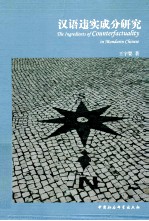
- 作 者:王宇婴著
- 出 版 社:北京:中国社会科学出版社
- 出版年份:2013
- ISBN:9787516138243
- 标注页数:286 页
- PDF页数:308 页
请阅读订购服务说明与试读!
订购服务说明
1、本站所有的书默认都是PDF格式,该格式图书只能阅读和打印,不能再次编辑。
2、除分上下册或者多册的情况下,一般PDF页数一定要大于标注页数才建议下单购买。【本资源308 ≥286页】
图书下载及付费说明
1、所有的电子图书为PDF格式,支持电脑、手机、平板等各类电子设备阅读;可以任意拷贝文件到不同的阅读设备里进行阅读。
2、电子图书在提交订单后一般半小时内处理完成,最晚48小时内处理完成。(非工作日购买会延迟)
3、所有的电子图书都是原书直接扫描方式制作而成。
Foreword 1
List of Abbreviations 1
CHAPTER ONE INTRODUCTION 1
1.1 Theories of Conditionals and CFCs 1
1.2 Goals of This Book 11
1.3 Some Basic Concepts of Conditionals 13
1.3.1 Various Conditionals 13
1.3.2 Examining the Grammatical Features of Conditionals 18
1.4 Structure of This Book 20
CHAPTER TWO A SURVEY oF CoNDITIoNALS AND CFCS IN CHINESE 21
2.1 Chinese Conditionals 21
2.1.1 Conditionals vs. Hypotheticals:A New Definition 22
2.1.2 Subclassification of Conditionals 26
2.1.3 Chinese and English Conditionals 29
2.1.3.1 Chinese Donkey Sentences 29
2.1.3.2 Tense Expressions 34
2.1.4 Some Grammatical Features of Conditionals in Chinese 40
2.1.4.1 Hypothetical Conjunctions 40
2.1.4.2 The Components of a Conditional 42
2.1.4.3 Subjectivity in Conditionals 44
2.1.4.4 Conditional as a Typical Irrealis Modal Sentence 45
2.2 Some Basic Concepts about CFCs 47
2.2.1 Definitions 48
2.2.2 CF Sentence as Subjectivised Construction 50
2.2.3 Modality and CFC 51
CHAPTER THREE LITERATURE REVIEW 55
3.1 Early Stage(before 1980s) 58
3.2 Middle Stage(mid 1980s to early 2000s) 61
3.2.1 Guohua Chen(1988)and Yan Jiang(2000) 62
3.2.2 Weixian Wang et a1.(1994),Fuyi Xing(2001)and Jiaxuan Shen(2003) 65
3.3 Recent Stage(Since the beginning of the 21 st century till now) 72
3.3.1 Realis vs.Irrealis-Xiaoying Luo(2006),Min Li(2006),Xiaoling Wang(2007),Xueping Zhang(2008) 73
3.3.2 Psychological Experimental Approach 81
3.3.3 Linguistic Approach(Yaoshi(要是)vs.Yaobushi(要不是)—Yuying Su(2008)) 84
CHAPTER FOUR CF INGREDIENTS(I):TEMPORAL EXPRESSIONS 89
4.1 A Brief Review of the Previous Studies on Temporal Structure in Chinese 90
4.1.1 Tripartite Temporal Structure-Ping Chen(1988) 91
4.1.2 Formal Approaches-Yan Jiang&Haihua Pan(2005) 93
4.1.3 Temporal Reference-Yang Gu(2007) 95
4.1.4 Relevance-Account of le(了)and guo(过)-Ljungqvist(2007) 96
4.2 An Analysis Based on Tripartite Temporal System 98
4.2.1 Phase 98
4.2.2 Aspect 110
4.2.3 Tense 126
4.3 More on Temporal Anchoring 134
4.4 Interim Summary 140
CHAPTER FIVE CF INGREDIENTS(Ⅱ) 144
5.1 Hypothetical Conjunctions 144
5.1.1 Ruguo(如果)(Yaoshi(要是),Yao(要),Jiaru(假如),Jiashi(假使),Jiashe(假设),Tangruo(倘若),Ruruo(如若),Sheruo(设若),etc.) 149
5.1.2 Yaobushi(要不是)(Ruofei(若非),Ruobushi(若不是),Ruguobushi(如果不是),etc.) 151
5.1.3 Wanyi(万一) 152
5.1.4 A Brief Summary 154
5.1.5 CF Sentences Without Conjunctions 155
5.2 Negation 156
5.3 Personal Pronouns 171
5.4 Rhetorical Questions 175
5.5 CF Enhancers 181
5.6 Summary 187
CHAPTER SIX GENERATING COUNTERFACTUALITY IN MANDARIN CONDITIONAL SENTENCES 188
6.1 Context Determinism vs.Ingredient Determinism 188
6.2 Minimalism,Contextualism and Indexicalism 191
6.3 A Three-Layer Context System 198
6.3.1 CF Ingredients:Local Context 199
6.3.1.1 CF Ingredients Revisited 199
6.3.1.2 Numbers Talk 206
6.3.1.3 Working Mechanism 211
6.3.2 Protasis and Apodosis:Compound Sentence Context 221
6.3.2.1 Binding Argument 222
6.3.2.2 From Protasis to Apodosis:A Process of Saturation 224
6.3.3 Macro Context 232
6.3.4 Interaction of Three Layers of Contexts 236
CHAPTER SEVEN CONCLUSIONS AND PROSPECTS FOR FUTURE RESEARCH 238
7.1 More on the Interpretational System 238
7.2 Recapitulation 244
7.3 Suggestions for Future Research 248
REFERENCES 252
APPENDIX Ⅰ 264
APPENDIX Ⅱ 266
APPENDIX Ⅲ 267
APPENDIX Ⅳ 274
APPENDIX Ⅴ 283
Acknowledgements 285
